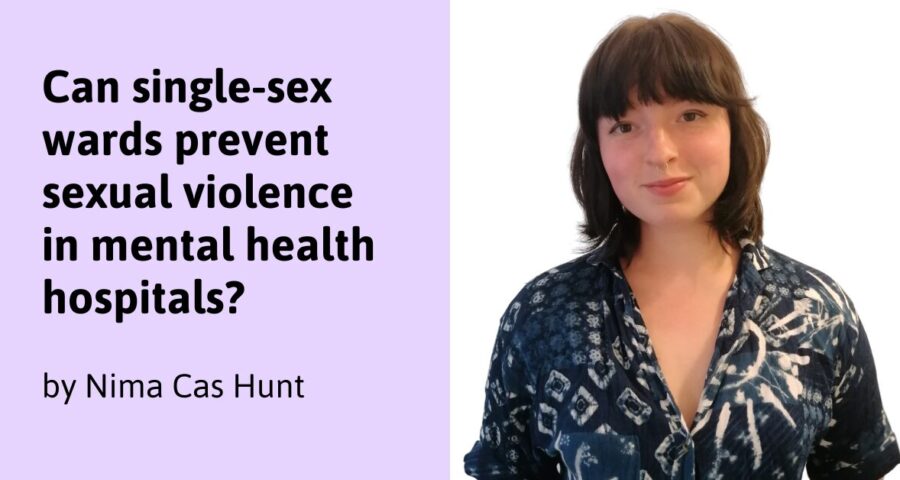Content note: sexual abuse
A joint investigation by The Independent and Sky News, published earlier this week, revealed that nearly 20,000 ‘sexual incidents’ in psychiatric hospitals had been reported to NHS mental health trusts over the last five years. One article by The Independent contains the stories of a man and five women, all victims of sexual abuse, assault, or rape, whilst admitted to NHS-funded placements in psychiatric units. I am one of the people whose story is shared in this article.
In 2017, I was groomed and sexually abused by a male member of staff at a child and adolescent psychiatric unit owned by The Huntercombe Group. The hospital, Watcombe Hall, closed later in 2017 after it was placed into special measures and received an ‘inadequate’ rating by the Care Quality Commission. From its opening, Watcombe Hall had developed what’s known as a ‘closed culture’ – a culture that enables (or is unable to prevent) harm and abuse.
Reader’s responses to the findings of this investigation – and stories like mine – have been frighteningly single-track minded. Commenters like Labour MPs Jess Phillips and Wes Streeting have suggested that single-sex wards would reduce sexual violence in mental health hospitals; this view has been endorsed and promoted by many other readers. In a later-published article written in reference to their earlier editorial, The Independent themselves suggested that it would be a ‘good start […] for the Conservatives to finally honour the pledge they made in 2010 to end the use of mixed-sex wards’.
As a survivor of sexual violence in mental health hospitals, I find this deeply concerning. Firstly, the suggested implementation of single-sex wards appears to be a politically-fuelled “sticking-plaster” solution to what is, in reality, a complex, deep-rooted and systemic issue plaguing the UK’s mental healthcare system. None of the people whose stories were shared in this investigation were victims of sexual assault or abuse purely because they were placed on a mixed-sex ward; they were victims of abuse because they were placed on wards where they weren’t protected from harm by fellow patients and hospital staff (of all genders) alike. When a person is admitted to a mental health hospital, the hospital has a duty of care to protect that person from harm in the hospital – so if a person is harmed, the hospital should be held to account. Segregating male and female patients overlooks the institutional factors that lead to an environment where patients aren’t safe; if these factors go unchallenged, then abuse of patients, in all its forms, continues to happen. Single-sex wards can’t fix systematic malpractice.
Besides, there’s a lack of modern research that convincingly argues in favour of single-sex mental health wards preventing abuse. The data uncovered by Sky News and The Independent doesn’t support single-sex wards being objectively safer environments; whilst there were ‘at least 500 sexual assaults and incidents […] on mixed-sex wards or mixed-sex communal areas’ reported to NHS trusts since 2019, this was out of a total number of 19,899 sexual incidents. These figures indicate that less than 3% of the total number of sexual incidents occurred in mixed-sex wards, with the vast majority (more than 97%) having happened in single-sex spaces. More research into the relationship between mixed-sex wards and sexual violence in mental health units is needed before any kind of conclusions can be drawn about how single-sex spaces effect patient safety.
I worry about the impact of sex-based wards becoming standardised practice across all mental health inpatient services without consideration for the individual wishes, needs and circumstances of each patient. By their nature, sex-based wards are trans and non-binary exclusive, and are likely to put transgender people at considerable risk of harm; at a time when anti-transgender hate crimes are on the rise, and anti-transgender narratives are actively encouraged by senior governmental figures, promoting the use of sex-based wards just adds fuel to the fire. Admitting someone to a ward based on their assigned sex at birth (and not their gender) when that person is already struggling with their mental well-being could have devastating consequences.
Whilst it is absolutely true that some female survivors of sexual violence at the hands of men might feel safer (and thus more able to heal) in female-only institutions, it would be presumptuous to assume that all women feel safer in single-sex wards. The premise that people are safer around their own sex eradicates the voices of non-binary survivors, as well as women whose abusers were women, and men whose abusers were men.
As a concept, single-sex wards being “safer” than mixed-sex wards feeds a misogynistic, victim-blaming narrative that men “can’t help themselves” around women. Many women who end up in mental health hospitals will have already experienced violence at the hands of men; what kind of message does it send to these women if they are told they aren’t safe around men in a so-called “place of safety”? In my own experience, I know that an admission to an all-female ward following my experience of sexual abuse would only have prolonged my sense of utter powerlessness and unsafety. It wasn’t being admitted to a single-sex ward that allowed me to heal from abuse; it was receiving care in a therapeutic community setting, open to those of any gender, where I was supported to feel safe in the world by a service that actually kept me safe.
It’s easier to think of the cause of widespread sexual violence in mental health hospitals being mixed-sex wards than it is to acknowledge how profound and established the issues within the UK’s mental healthcare system are. Leaping on a single solution will only prolong institutional malpractice; to prevent sexual violence in mental health services, we must strive for tangible and extensive change in the way that we perceive, approach and manage mental ill-health and distress on a societal, procedural and governmental level.

